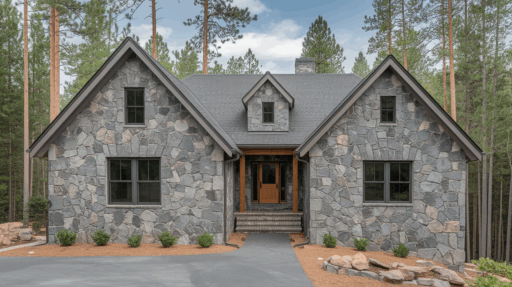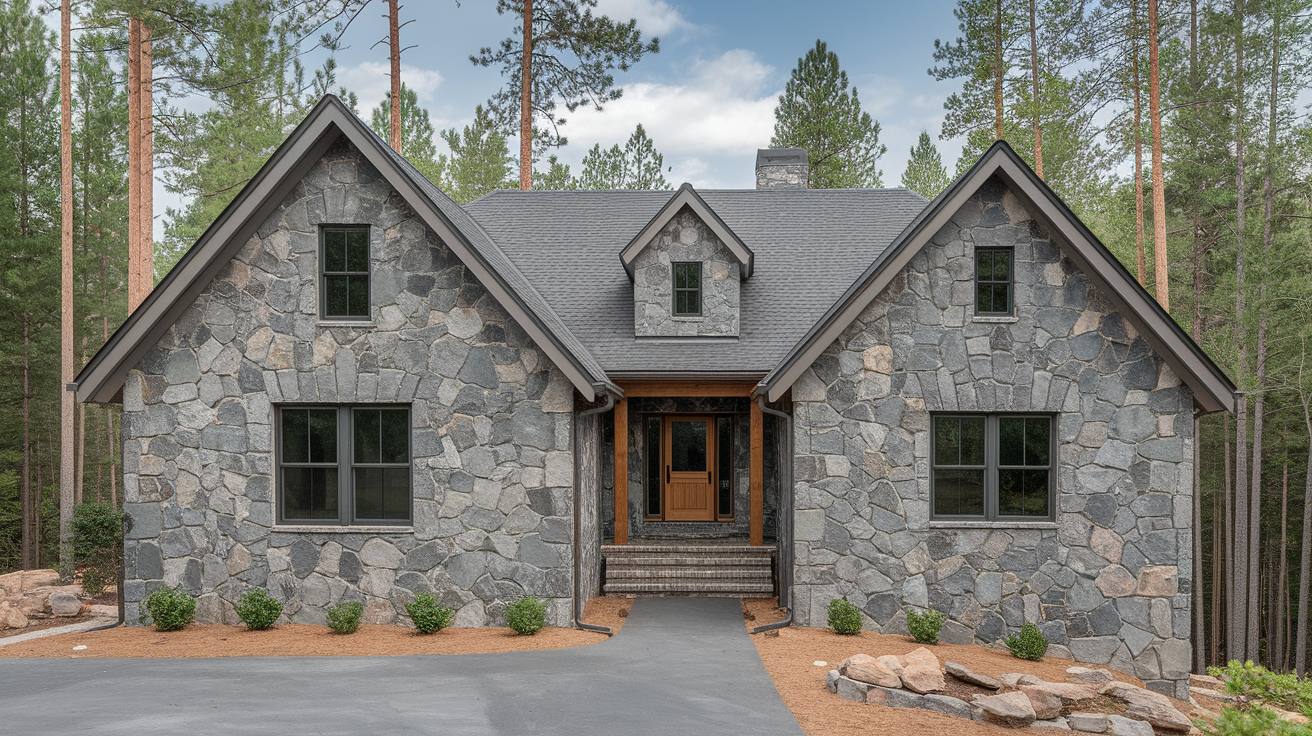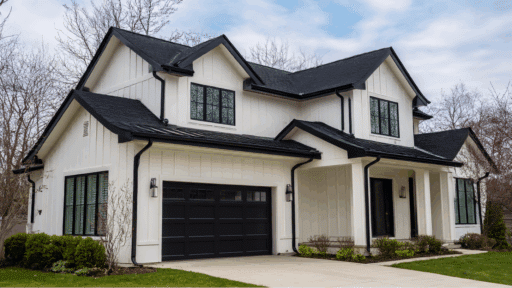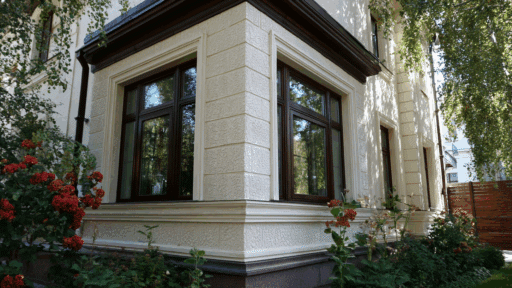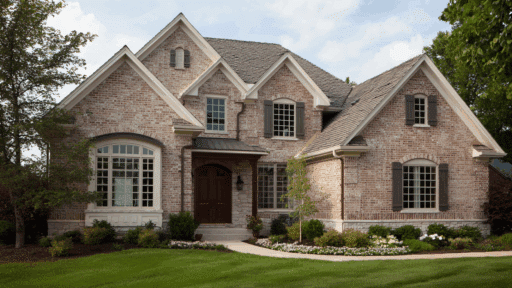Your house deserves a stone that tells its story. Choosing the right stone for your home’s exterior feels overwhelming. With so many options, where do you even start?
Stone isn’t just about looks. It protects your home from the weather, adds value, and creates that perfect first impression. If you want rustic charm or modern grace, there’s a stone that fits your vision.
Some stones work better in certain climates. Others need more care to stay beautiful. The good news? Understanding your options doesn’t require a geology degree.
This guide breaks down the most popular exterior house stones. You’ll learn what makes each one special: no complicated terms or confusing details. Just straight talk about what works, what doesn’t, and what fits your budget.
Ready to find your home’s perfect stone match?
Where Beauty Meets Endurance: The Magic of Stone Facades
Stone stands out as one of the most intelligent choices for home exteriors. Weather resistance tops the list since stone naturally fights off rain, snow, and extreme temperatures without cracking or fading.
Your home value gets a serious boost too, often adding thousands to your property’s worth. The low maintenance aspect means less work for you over the years.
Compared to other materials, stone holds clear advantages. Vinyl costs less upfront, but it can crack and look cheap. Brick limits your style options.
Stucco develops cracks in freeze-thaw cycles. Stone gives you lasting beauty, solid protection, and styles that never go out of fashion.
Popular Types of Exterior House Stone
Some rocks have earned their popularity through centuries of proven performance, while others shine in specific regions.
These stone types represent the most trusted options for creating beautiful, lasting exteriors that homeowners love.
1. Granite: Strength and Grace Combined
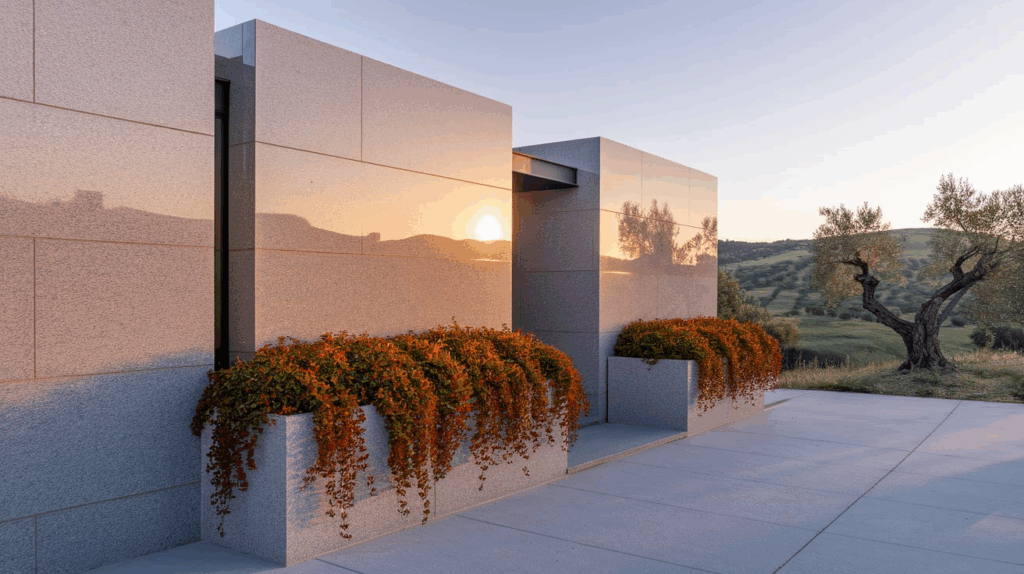
Granite stands as the superhero of natural stones, delivering unmatched durability for your home’s exterior. This igneous rock forms deep underground under intense heat and pressure, creating incredibly dense and complex material.
Granite weathers everything from harsh winters to blazing summers without losing its polished good looks.
Cost: Expect to pay $15-40 per square foot installed, making it a premium investment.
Distinguishing Feature: Speckled patterns from various minerals create unique, eye-catching designs that never repeat.
| Pros | Cons |
|---|---|
| Extremely durable | Expensive to install |
| Resistant to stains | It can be difficult to cut |
2. Understanding Limestone: Soft, Classic, and Refined
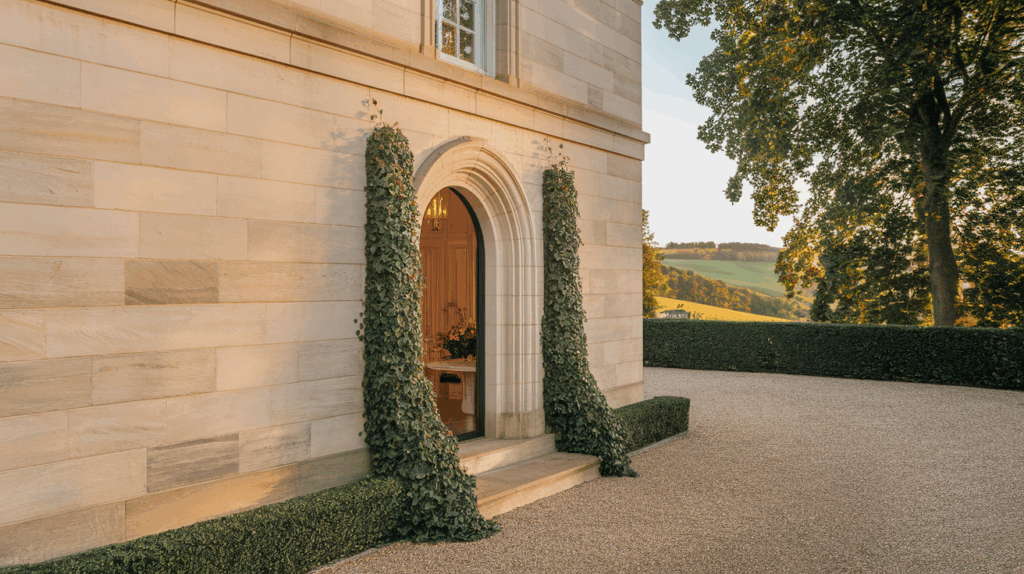
Limestone brings centuries of structural tradition to modern homes with its smooth, graceful appearance.
This sedimentary rock forms from compressed marine organisms, giving it a naturally soft texture that’s easy to cut and shape. Limestone works beautifully for both rustic farmhouses and sleek contemporary designs.
Cost: Budget around $10-25 per square foot installed for this mid-range option.
Distinguishing Feature: Subtle fossil patterns and uniform coloring create a clean, graceful look that ages gracefully.
| Pros | Cons |
|---|---|
| Elegant, light-toned appearance | Prone to weathering over time |
| Easy to shape and carve | Absorbs moisture if not sealed |
3. Charming Sandstone: Warmth in Every Grain
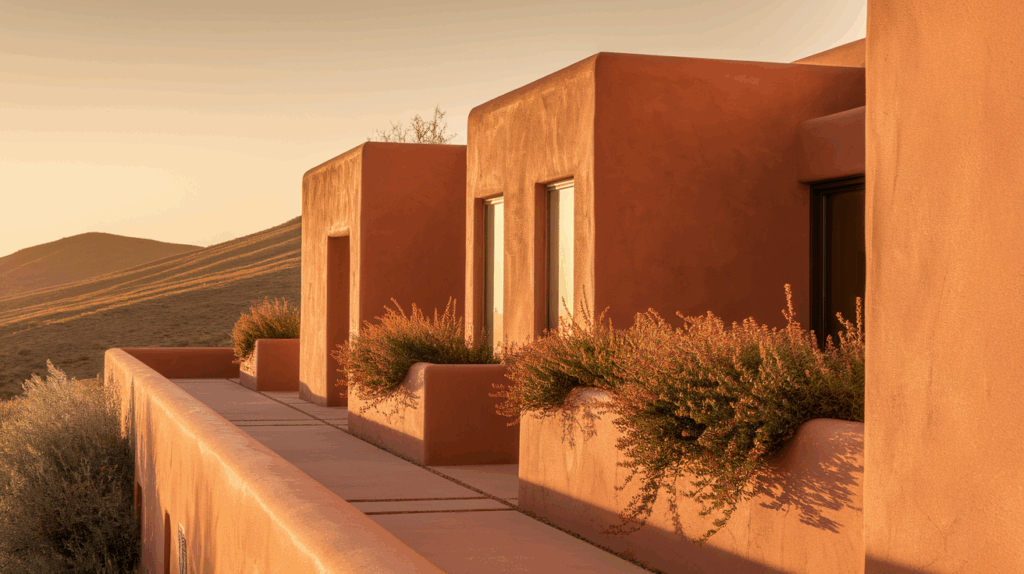
Sandstone captures the essence of desert landscapes and brings that warm, earthy feeling to your home’s exterior.
Formed from compressed sand grains over millions of years, this stone offers incredible variety in color and texture. Sandstone’s natural layering creates beautiful horizontal lines that add visual interest to any wall.
Cost: Plan for $12-30 per square foot installed, offering good value for natural stone.
Distinguishing Feature: Visible sand grains and natural layering create a texture you can see and feel.
| Pros | Cons |
|---|---|
| Natural earthy tones | Can erode in harsh climates |
| Easy to work with | Requires regular sealing |
4. Rugged Fieldstone: Nature’s Wild Personality

Fieldstone brings the untamed beauty of countryside walls to your home with its irregular shapes and weathered surfaces.
These stones come straight from fields and riverbeds, shaped by centuries of natural weathering. Fieldstone creates that authentic, old-world charm that makes your house look like it’s been standing for generations.
Cost: Typically runs $20-35 per square foot installed due to labor-intensive installation.
Distinguishing Feature: No two stones match, creating unique patterns with natural, weathered edges.
| Pros | Cons |
|---|---|
| Rustic, natural look | Irregular shapes are harder to install |
| Strong and weather-resistant | Heavier than other stones |
5. Sleek Slate: Smooth, Strong, and Stylish
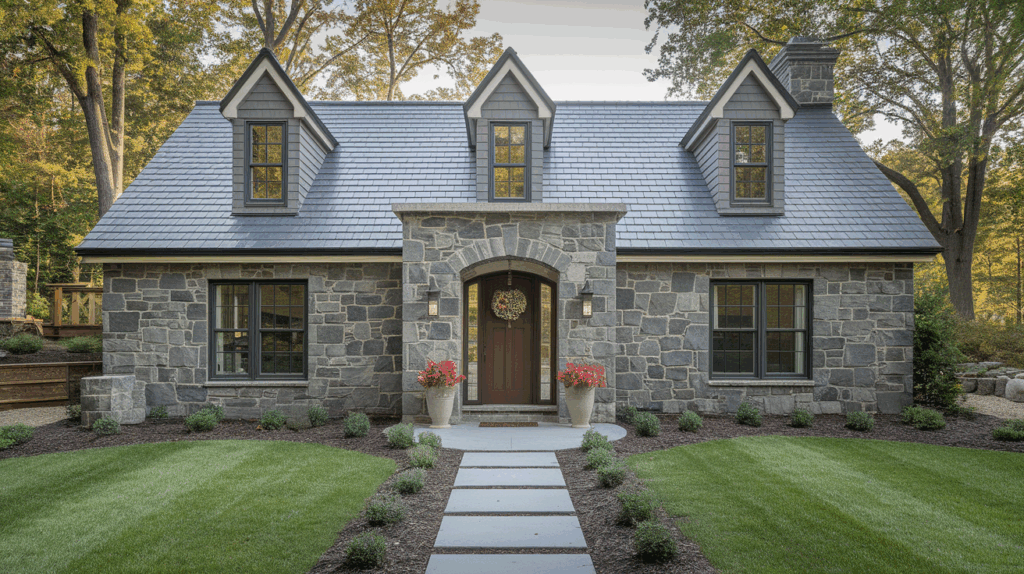
Slate delivers modern grace with its flat surfaces and rich, deep colors that never go out of style. This metamorphic rock splits naturally into thin, smooth sheets that create clean lines on your exterior walls.
Slate’s dense composition makes it incredibly weather-resistant while maintaining its graceful appearance for decades.
Cost: Expect to invest $15-35 per square foot installed for this premium material.
Distinguishing Feature: Natural splitting creates perfectly flat surfaces with subtle color variations and occasional metallic hints.
| Pros | Cons |
|---|---|
| Unique layered texture | Brittle if not properly handled |
| Resists moisture and mold | Limited color options |
6. Shimmering Quartzite: Luxury in Every Layer
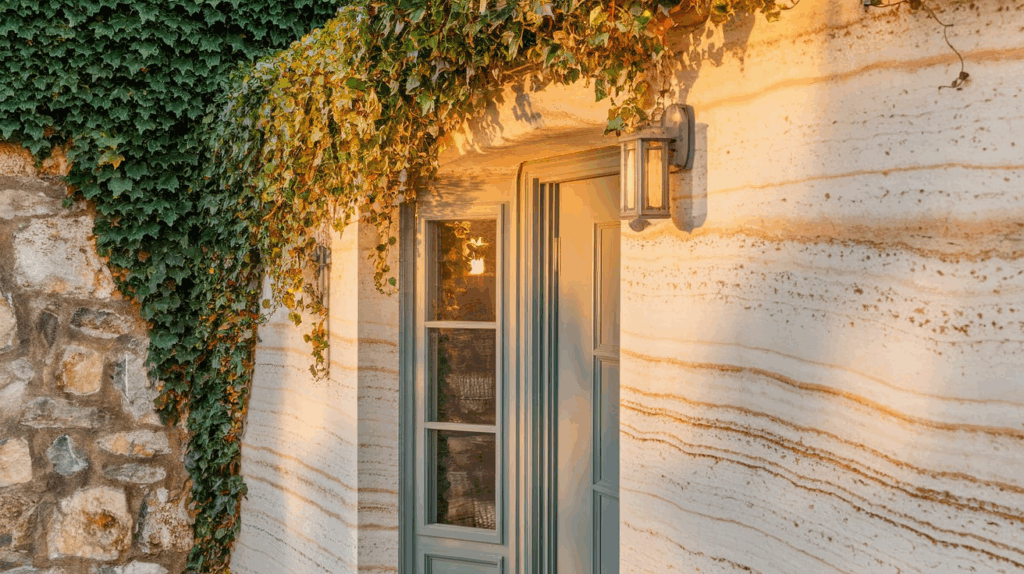
Quartzite brings sparkle and strength to your home’s exterior with its crystal-like appearance and incredible durability.
This metamorphic rock forms when sandstone changes under extreme heat and pressure, creating one of the hardest natural stones available. Quartzite’s subtle shimmer catches light beautifully throughout the day.
Cost: Premium pricing at $25-50 per square foot installed reflects its luxury status.
Distinguishing Feature: Natural quartz crystals create a subtle sparkle that changes with lighting conditions.
| Pros | Cons |
|---|---|
| Harder than granite | More expensive than similar stones |
| Highly resistant to weathering | Limited availability in some regions |
7. Marble Magic: Graceful Veins and Grace
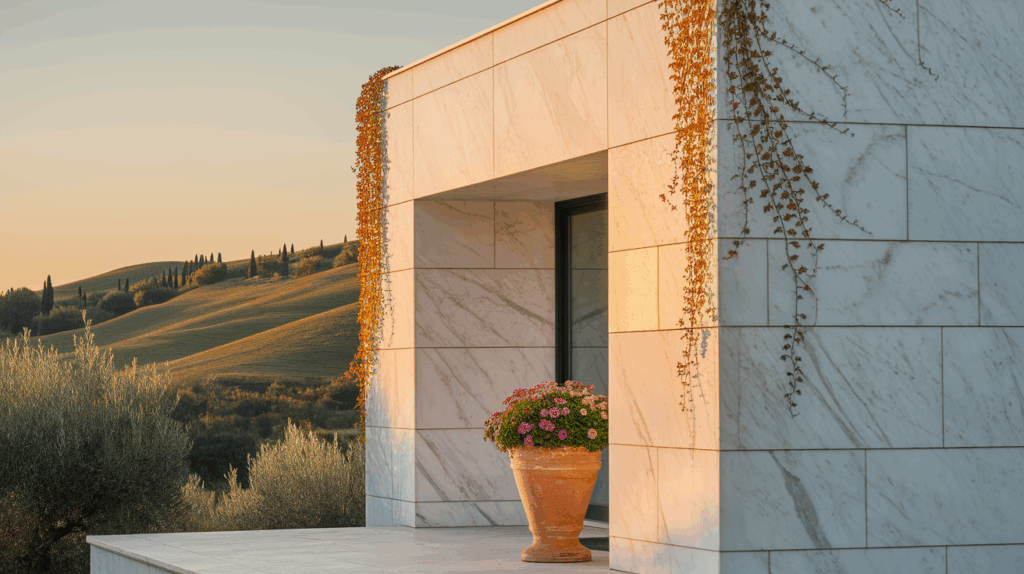
Marble change your home into a work of art with its flowing veins and never-ending grace. This metamorphic limestone develops graceful patterns through geological processes that create unique designs in every slab.
Marble has graced palaces and monuments for thousands of years, bringing that same grandeur to residential exteriors.
Cost: Luxury investment of $30-60 per square foot installed for exterior applications.
Distinguishing Feature: Distinctive veining patterns flow like rivers through the stone, creating natural artwork.
| Pros | Cons |
|---|---|
| Luxurious and classic appearance | Prone to staining and scratching |
| Polishes to a beautiful finish | Less suitable for harsh climates |
8. Travertine Tales: Rustic Beauty with Old-World Charm
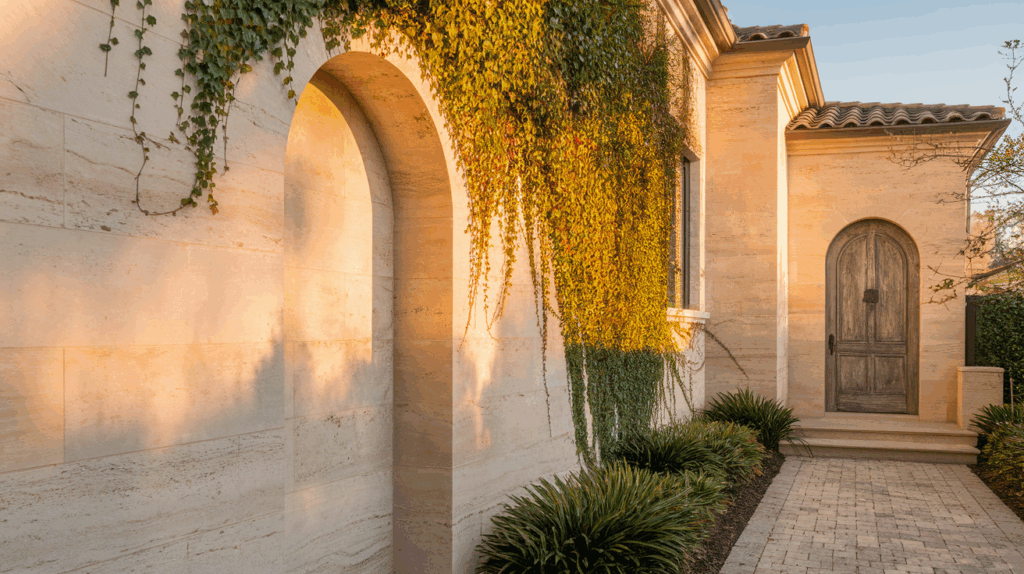
Travertine carries the romance of ancient Roman structure into modern home design with its warm, honey-colored tones.
This limestone variety forms around hot springs, creating natural holes and textures that give it character. Travertine weathers beautifully, developing a lovely patina that increases its rustic appeal over time.
Cost: Mid-range option at $12-28 per square foot installed offers accessible luxury.
Distinguishing Feature: Natural holes and porous texture create authentic Mediterranean character.
| Pros | Cons |
|---|---|
| Warm, textured appearance | Porous and needs sealing |
| Cool underfoot in hot climates | Can develop holes and pitting |
9. Bluestone Blues: Cool, Calm, and Collected
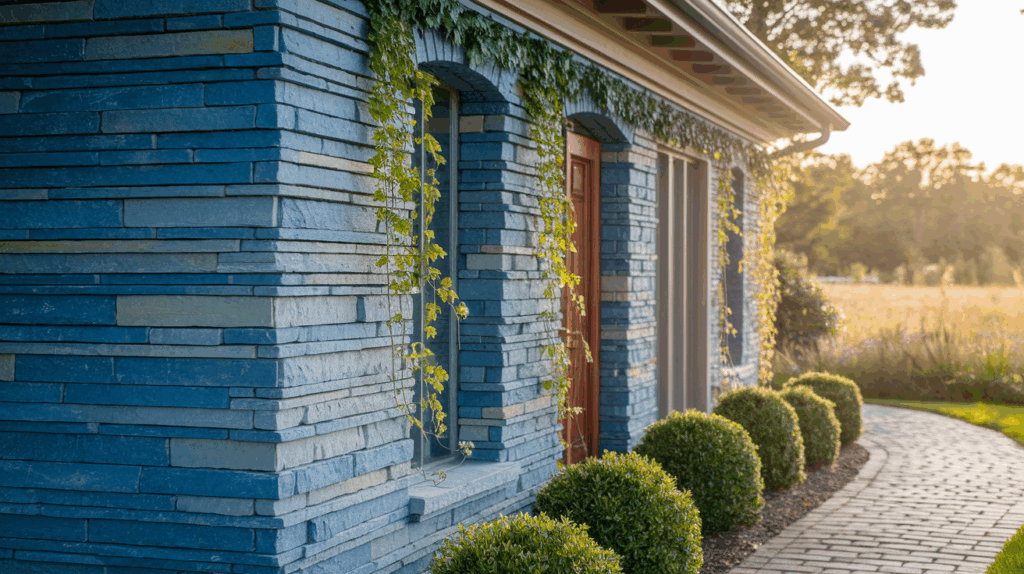
Bluestone brings serene grace to your exterior with its cool gray-blue tones and smooth texture. This sandstone variety has been America’s favorite for over 200 years, gracing everything from Colonial homes to modern masterpieces.
Bluestone’s consistent coloring and easy workability make it perfect for clean, contemporary designs.
Cost: Solid value at $15-30 per square foot installed for this American classic.
Distinguishing Feature: Distinctive blue-gray color with fine, even grain creates a calm, graceful appearance.
| Pros | Cons |
|---|---|
| Dense and slip-resistant | It can be costly compared to other stones |
| Rich blue-gray color tones | May fade in sunlight over time |
10. Bold Basalt: Dark Drama with Lasting Power
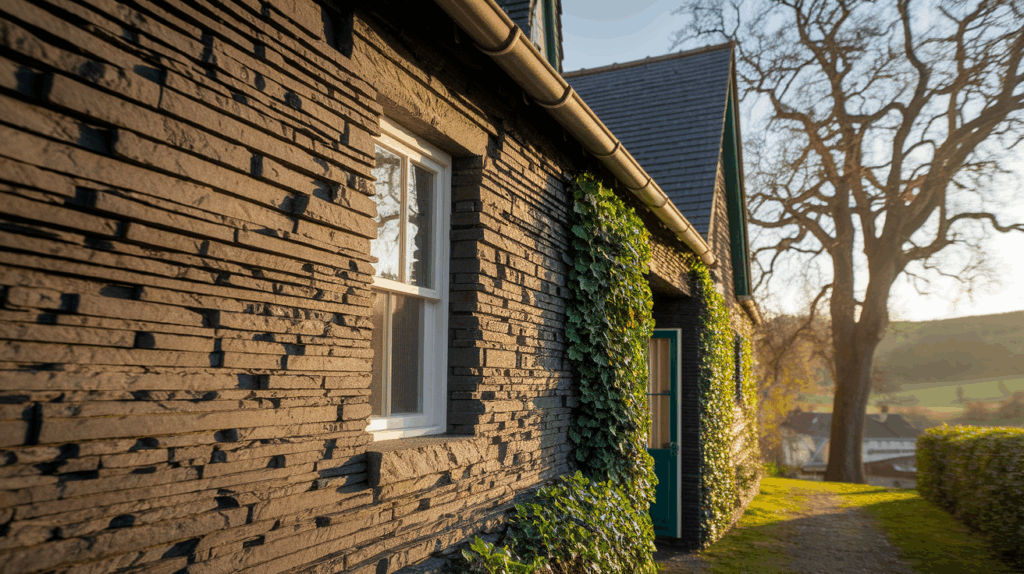
Basalt delivers striking dark beauty with the strength that comes from volcanic origins. This igneous rock forms when lava cools quickly, creating incredibly dense stone that laughs at weather extremes.
Basalt’s dark colors provide a dramatic contrast and make other structural elements pop.
Cost: Specialty pricing of $20-40 per square foot installed reflects its unique volcanic origin.
Distinguishing Feature: Deep charcoal to black coloring with fine-grained texture creates bold, modern statements.
| Pros | Cons |
|---|---|
| Strong and highly durable | Limited color variety (mostly dark) |
| Great for contemporary designs | May require sealing to avoid stains |
11. Sparkling Schist: Texture with a Touch of Glam
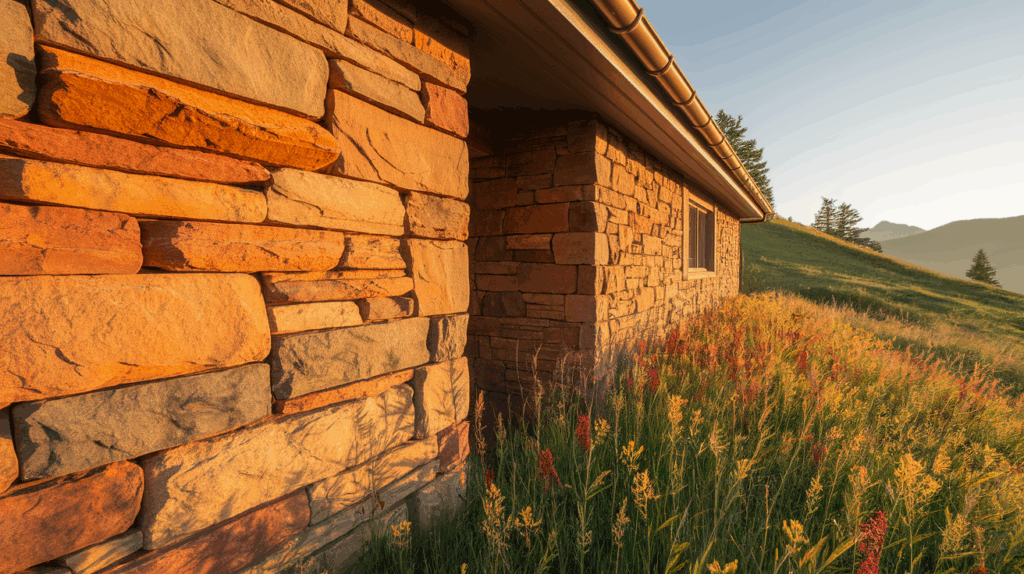
Schist adds sparkle and texture to your exterior with its distinctive layered appearance and mica flakes that catch sunlight.
This metamorphic rock forms under moderate heat and pressure, creating beautiful foliated patterns that add visual interest. Schist’s natural shimmer changes throughout the day as light hits its crystalline surfaces.
Cost: Unique option priced at $18-35 per square foot installed for its distinctive appearance.
Distinguishing Feature: Visible mica flakes create natural sparkle with layered, textured surfaces.
| Pros | Cons |
|---|---|
| Sparkly, unique visual appeal | Flaky texture can be difficult to manage |
| Great natural insulation | Less consistent in density |
12. Soapstone Simplicity: Understated Yet Resilient
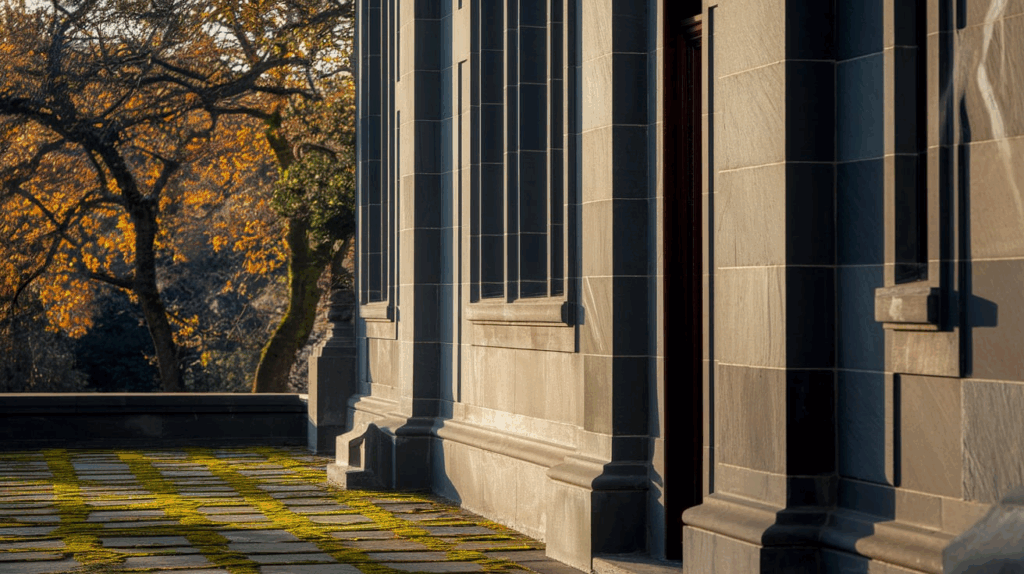
Soapstone offers quiet grace with its smooth, matte finish and incredible resistance to weathering and chemicals.
This metamorphic rock feels almost soft to the touch despite its durability, creating a unique tactile experience. Soapstone’s subtle beauty and low maintenance make it perfect for homeowners who prefer understated grace.
Cost: Specialty investment of $25-45 per square foot installed for its unique properties.
Distinguishing Feature: Naturally smooth, almost soft texture with excellent weather resistance and minimal maintenance needs.
| Pros | Cons |
|---|---|
| Smooth and easy to cut | Can darken over time |
| Naturally stain-resistant | Softer than other stones |
13. Tuff Texture: Lightweight Stone with Ancient Soul
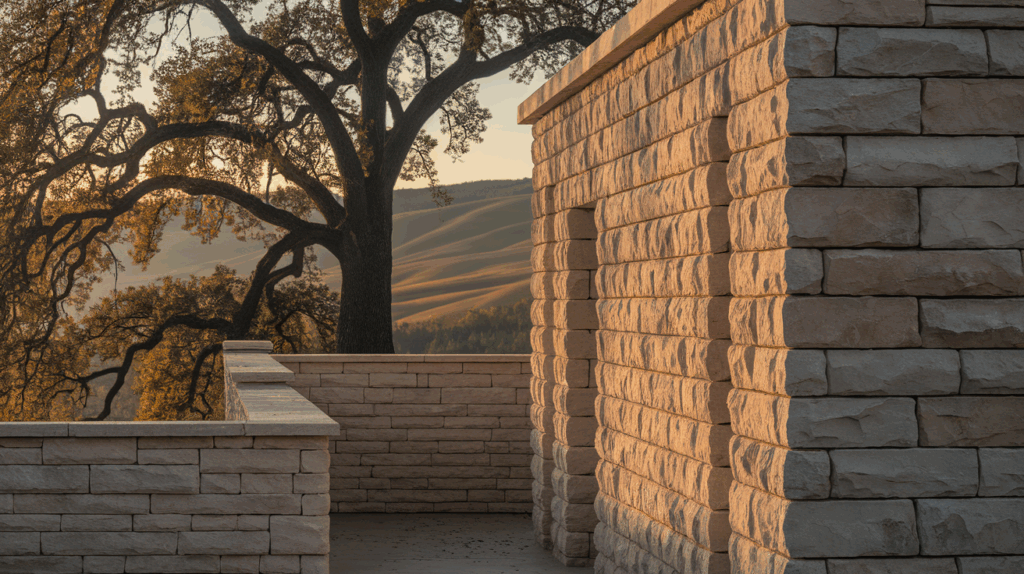
Tuff brings volcanic history to your home with its lightweight yet durable composition formed from compressed volcanic ash.
This unique stone offers the look of solid rock without the extreme weight, making it easier to install and less demanding on your home’s structure. Tuff’s porous nature provides excellent insulation properties.
Cost: Specialized option at $20-35 per square foot installed due to limited availability.
Distinguishing Feature: Lightweight volcanic composition with natural insulation properties and distinctive texture.
| Pros | Cons |
|---|---|
| Lightweight and easy to shape | Less durable than denser stones |
| Unique volcanic stone appearance | Can crumble under heavy stress |
Factors to Consider When Choosing Stone
Picking the perfect stone involves more than just falling in love with how it looks. Your local weather, your home’s structure, and your long-term plans all play important roles in making the right choice.
Smart planning now prevents costly surprises later and ensures your stone exterior stays beautiful for decades.
- Climate Suitability: Choose stones that handle your local weather, as freeze-thaw cycles crack softer materials while granite and slate resist temperature swings and harsh conditions.
- Weight and Structural Support: Ensure your home’s structure can safely support the stone’s weight, with heavy options like granite potentially requiring foundation reinforcement.
- Incredible Goals: Match your stone choice to your design vision. For modern homes, a clean slate is ideal; rustic styles require irregular fieldstone, while traditional houses suit classic limestone.
- Budget and Installation Costs: Factor in both material costs and labor complexity, as irregular stones require more skilled installation than uniform cuts, plus potential structural modifications.
- Long-term Maintenance: Consider your willingness to maintain the stone over time, since dense materials need minimal care while softer stones may require regular sealing and cleaning.
Benefits of Exterior House Stone
Adding stone to a home’s exterior instantly enhances curb appeal while providing functional advantages. If you use as an accent or a full facade, stone offers durability and texture. It pairs beautifully with white exteriors and black windows, creating rich visual contrast and architectural depth.
1. Long-Lasting Durability
Stone is one of the most durable exterior materials available. It holds up against extreme weather—be it sun, rain, snow, or wind—without deteriorating like wood or synthetic siding.
Unlike paint or stucco, it won’t peel, fade, or crack over time, and it resists mold, pests, and rot naturally. This longevity makes it a wise choice for homeowners who want a one-time investment that lasts for decades with minimal upkeep.
2. Visual Texture and Natural Appeal
The natural patterns and variations in stone create beautiful texture and depth that paint or siding simply can’t replicate. If you choose rugged fieldstone or smooth-cut limestone, the organic tones and layers add richness and warmth to the exterior.
When paired with a white house and black windows, stone softens the sharp contrast and introduces earthy elements, grounding the design in natural beauty. It works across styles—from modern to rustic farmhouse.
3. Low Maintenance Requirements
One of the most significant advantages of stone is that it practically takes care of itself. Unlike wood, which needs staining or sealing, or siding that may need repainting, stone retains its appearance without frequent intervention.
A simple rinse with water now and then is enough to keep it clean. There’s no worry about warping, insect damage, or moisture penetration, making it an ideal choice for busy homeowners or those in variable climates.
4. Increased Property Value
Stone exteriors are widely seen as a premium feature that adds both visual interest and perceived quality to a home. Properties with stone accents often stand out to buyers, giving the impression of a well-built, luxurious home.
In many cases, homes with exterior stonework appraise for more and sell faster than those without. It’s not just about looks—buyers recognize that stone adds real, long-term value.
Conclusion
Your home’s exterior stone choice comes down to three key factors: matching your personal style vision, ensuring your structure can safely support the material, and selecting stone that thrives in your local climate conditions.
Don’t tackle this project alone. Professional consultation makes the difference between success and costly mistakes.
The right stone changes your house into a home that tells your story. Take time to research, plan carefully, and invest in quality installation. Your future self will thank you every time you pull into the driveway.
Share your ideas in the comments below! Which stone type caught your eye, or do you have experience with any of these materials? Drop a comment and let’s discuss your stone exterior experience!

